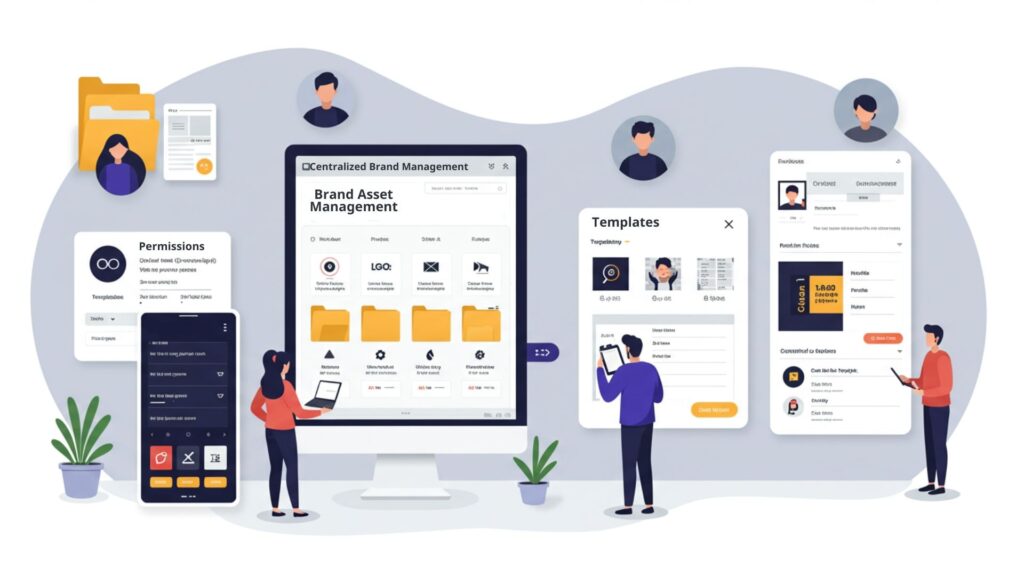Modern marketing demands an always-on, omnichannel experience, making it imperative yet difficult to maintain a unified brand identity. Teams are distributed, campaigns launch at record speed, and customers interact with content across countless touchpoints. Without a centralized approach to managing brand guidelines, businesses often struggle to ensure consistency in how their brand shows up across regions, departments, and platforms. These dynamics result in confusion, diluted messaging, and missed opportunities to build lasting brand equity.
That’s where brand guidelines software steps in. This isn’t just a digital version of your old PDF brand book. Instead, it’s a scalable, dynamic solution that gives brand owners, designers, marketers, and partners a shared source of truth.
As brand governance evolves to meet the demands of real-time content creation and personalization, leading companies are turning to smart, AI-driven tools to help define, organize, and enforce design elements like logo usage, typography, tone, and visual identity. By embedding brand standards directly into daily workflows, businesses can empower teams to create with clarity and confidence, no matter where they are or what channel they’re working in.
Why Brand Guidelines Software is Essential for Brand Consistency
As brands expand their presence across digital, print, and experiential channels, the challenge of maintaining a consistent look, feel, and voice becomes more complex. Relying on static files or tribal knowledge no longer cuts it, especially for companies managing a growing library of brand assets and collaborating with multiple teams and partners. Brand guidelines software creates a central, interactive hub that evolves with your brand and makes guidelines accessible in real time.
Going Beyond Static Brand Books
Traditional brand books (often buried in shared drives or outdated PDFs) don’t support the agility marketing demands. With software, businesses can provide always-current guidance that updates automatically as the brand evolves. From typography and logo treatments to brand tone and usage examples, these tools turn passive documents into living, searchable platforms.
Aligning Internal and External Stakeholders
Along with internal discipline, brand consistency requires external alignment. Whether you’re working with agency partners, freelancers, or regional teams, guidelines must be accessible, clear, and easy to apply. Software tailored for brand guidelines ensures that everyone from creative teams to external vendors has the same understanding of how the brand should be presented across every channel.
Centralize and Control Brand Assets with Ease
When brand assets are scattered across folders, inboxes, or outdated platforms, teams waste time searching for the right files and risk using the wrong ones. Brand governance software creates a unified space where everything from logos to templates is stored, versioned, and governed with precision. You can then bring structure and intelligence to the way brand elements are managed and deployed across your business.

One Source of Truth for Brand Owners
Managing brand identity requires clarity and control, especially when multiple teams are creating content. Having a centralized hub for all brand assets—logos, typography files, image libraries, templates, and more—ensures that brand owners always know what’s approved, what’s current, and what’s being used. This “single source of truth” approach reduces confusion and safeguards the integrity of the brand at every touchpoint.
Reducing Risk of Off-Brand Content
When teams don’t have easy access to the right design elements, they improvise. That can lead to inconsistencies that erode customer trust. By embedding access to up-to-date assets directly within content creation workflows—whether it’s a presentation, a digital ad, or a product page—brand guidelines software minimizes the risk of off-brand outputs.
Smart permissions and usage controls also make it easy to limit asset access by role, region, or project, which helps large teams stay in line without sacrificing creativity.
Organize and Customize Access Based on Roles and Use Cases
Different users need different tools. A designer creating campaign visuals requires high-res logo files, style guides, and editable templates. Meanwhile, a sales rep might only need access to a branded pitch deck or product sheet. With intelligent software, you can create curated asset collections and permission-based views that serve the right content to the right people without overwhelming them.
By segmenting access by department, region, or use case, brand owners can ensure that every team sees only the assets and guidelines relevant to their role. For example, you might create a campaign-specific asset pack for your European marketing team that includes localized imagery, approved taglines, and regional compliance guidelines while keeping global brand governance intact. It’s a smarter, more scalable way to maintain brand integrity while supporting agility across the business.
Strengthen Your Brand Identity Through Visual Consistency
Your brand’s visual identity is often its first and most lasting impression. Whether it’s a social post, a sales deck, or a product label, how your brand looks and feels needs to be instantly recognizable. Brand asset software helps reinforce that visual consistency at scale, translating design intent into daily execution so that teams can move fast without compromising brand integrity.
Enforce Visual Identity at Scale
Maintaining visual cohesion across channels and geographies can be difficult, especially for growing or global brands. Guidelines around color usage, logo placement, image treatments, and typography are often interpreted differently depending on who’s applying them.
With software, those interpretations become standardized. Interactive brand design systems—complete with examples, usage rules, and downloadable files—help ensure that every asset created reflects the brand’s intended personality and style, no matter who’s behind the keyboard.

Empower Teams to Create On-Brand Content Quickly
Creative bottlenecks often arise when every asset needs to pass through a central design team. To scale content production without sacrificing brand standards, brand software allows marketers, salespeople, and partners to access pre-approved templates and design elements. Teams can create with confidence while staying aligned with brand expectations, boosting both efficiency and brand consistency.
Streamline Collaboration Across Distributed Teams
As remote work, global expansion, and cross-functional marketing become the norm, keeping everyone aligned on brand expectations is no small feat. With people working across time zones and teams relying on different tools, organizations must create a centralized system that enhances collaboration without slowing anyone down. The right software makes brand governance a shared responsibility without introducing friction.
Make Brand Guidelines Accessible Anytime, Anywhere
Modern brands live in the cloud, and so should their guidelines. By making brand standards and assets easily accessible online through any device, brand software removes the guesswork from everyday content creation. Whether it’s a new designer onboarding in Europe or a sales lead in the field updating a deck, everyone has instant access to the latest guidelines, examples, and files in context.
Enable Feedback Loops Without Bottlenecks
Endless email threads and stalled reviews kill momentum. With built-in collaboration features like commenting, approval workflows, and change tracking, brand guidelines software keeps projects moving while maintaining control. Brand owners can review how assets are being used, share feedback in real time, and stay confident that design and messaging are aligned with brand expectations, all without slowing down creative output.

Brand Asset Software as a Growth Enabler
A brand isn’t static; it evolves as your company expands into new markets, launches new products, or repositions to meet changing customer needs. But with growth comes complexity, and that’s where many brands begin to lose consistency. Scalable brand software helps turn branding into an adaptive business asset that grows with you while remaining clear, controlled, and cohesive.
Scale Branding Across Products, Regions, and Teams
Whether you’re launching a new product line, entering a global market, or managing sub-brands under a parent company, consistency across the board is a must. With modular guidelines and role-based access, AI-driven software makes it easy to segment guidance for different teams, regions, or product groups while maintaining a unified brand identity. Having flexibility allows companies to expand without compromising the clarity or strength of their core brand.
Accelerate Campaign Development and Brand Rollouts
When every new campaign or initiative starts from scratch, time and resources are lost. Instead, brand governance software allows teams to tap into pre-built templates, brand-aligned assets, and usage examples that help them get from concept to execution faster.
Marketing teams can launch campaigns with greater confidence, knowing that the visual and verbal expression of the brand has already been baked in. No matter the medium, organizations can deliver a consistent experience to customers.
Evaluating Brand Guidelines Software: What to Look For
While many tools offer a basic digital repository for logos and brand rules, the true value lies in how well the platform adapts to your organization’s structure, scales with growth, and empowers users across functions. As brand leaders take on broader mandates from ensuring compliance to enabling creativity, it’s important to choose a solution that balances control with agility.
Must-Have Features for Brand Owners and Creatives
Look for platforms that offer more than static documentation. You’ll want tools that centralize brand assets but also make them actionable within your team’s day-to-day workflows. That means interactive brand guidelines, smart templates, AI-powered tagging and search, and customizable permissions.
For example, a marketing lead launching a regional campaign should be able to quickly access relevant templates and localized assets, while a creative director should be able to update brand typography once and have it automatically reflected across every design system.
Version control is also essential. Your brand will evolve through refreshes, new campaigns, M&A activity, or product diversification, and your guidelines platform must evolve with it. Choose software that supports flexible governance, enables real-time updates, and maintains a historical archive of past versions so you can track how your brand has changed over time.
Questions to Ask Before You Buy
To avoid investing in a tool that can’t scale with your brand, ask the following:
- Does this platform support multiple brand instances or sub-brands? Essential for holding companies, multi-product portfolios, or brands managing both B2C and B2B channels.
- How well does it integrate with the tools our teams already use? Look for integration with creative suites (e.g., Adobe), CMS platforms, marketing automation tools, and project management systems.
- Can it automate repetitive tasks, like resizing assets or updating templates across markets? AI-driven automation can significantly boost efficiency and reduce errors.
- Is the platform intuitive for non-designers? Sales teams, customer success reps, and external partners should be able to access and apply brand elements without extensive training.
- How are access controls and usage rights managed? You’ll want granular control to manage who can edit, download, or share assets based on roles, regions, or teams.
Use Case: Rolling Out a Global Rebrand
Let’s say your company is launching a full-scale global rebrand. You need to align internal teams, creative partners, media agencies, and local market teams across dozens of regions while staying on schedule. With the right software, you can house new assets and templates, roll out updated design elements, define usage rules by region, and train teams through embedded video or interactive modules. No manual emails, no outdated decks—just a central hub where everyone works from the same playbook.
Expert Tip: Future-Proof Your Brand Ops
Don’t just evaluate based on today’s needs. Ask yourself what kind of brand governance infrastructure your company will need in 12 or 24 months. The best brand guidelines software becomes an operational engine not just for brand design but for creative collaboration, campaign velocity, and business impact. It’s the foundation for a modern, scalable brand system that grows with your organization.
Empower Teams and Future-Proof Your Brand
Maintaining a consistent, high-impact brand presence doesn’t happen by accident. It requires the right mix of tools, strategy, and structure. As companies scale, the pressure to deliver fast, on-brand content across teams and regions only grows.
Brand guidelines software helps close the gap between brand intent and brand execution by turning your guidelines into an active part of the creative process. From centralizing assets to enforcing visual identity and accelerating collaboration, it empowers everyone in your organization to create with confidence.
At Aprimo, we’ve built our platform to go far beyond static style guides. We help brand owners develop scalable, intelligent brand ecosystems that adapt in real time, support evolving creative workflows, and ensure consistency across every touchpoint. With AI-powered tagging, version control, modular brand architecture, and dynamic template integration, our software is designed to meet the needs of modern, fast-moving teams. Book a personalized demo today to bring clarity, control, and creativity to your brand operations.


